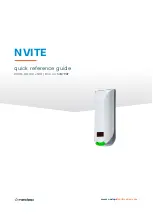
XVME-200/290 Manual
December, 1987
3.3.1.3
PI/T Timer Interrupt Enabling
68230 timer interrupts are enabled/disabled via PORT C output pin PC4. When PC4
is negated (logic ‘l”), the timer cannot generate VMEbus interrupts. When PC4 is
asserted (logic “0”), the timer will generate VMEbus interrupts.
When the timer interrupts are to be used, PORT C pins PC3/TOUT and PC7/TIACK
must be programmed to serve the timer interrupt request and acknowledge functions.
Pin PC4 is then used to determine whether timer interrupts are enabled or disabled.
All interrupt related PORT C pins are connected to pull-up resistors,
SO
that when
the module is reset all PORT C lines will be configured as inputs and thus, all
module interrupts will be disabled.
During the interrupt service routine, the ‘Direct Method” must be used for clearing
the timer zero detect status bit in order to negate the interrupt (refer to the 68230
Manual for information on the “Direct Method” of clearing the timer).
When the timer interrupts are not going to be used, pin PC4 must be negated (logic
“1’) in order to disable timer interrupts.
In these cases, pin PC3/TOUT can be
programmed either as a simple timer output or as a general purpose PORT C output
line.
3.4
PI/T PORT A AND PORT B DATA LINES
The I/O lines connected to the PI/T I/O pins are labeled PA0-PA7 and PB0-PB7
(refer to Figure 1-1 of this manual). The PORT A and B data lines are indepen-
dently buffered by 8-bit transceivers. The 8 I/O lines assigned to each port must
all assume the same direction. Thus, all I/O lines in PORT A must assume the same
direction, and all the data lines in PORT B must assume the same direction. PORTS
A and B may however, assume different directions.
The direction of the 8-bit data transceivers which buffer each port is programmed
independent of the direction of the PORT I/O lines on the PI/T chips. The
direction of the data transceivers is programmed via the PORT C outputs PCO and
PCl. The state of the P CO and PC1 outputs should be programmed to be consistent
with the programmed direction of the PI/T ports.
When programming a port for output the direction of the transceiver and the port
should be set in the following sequence:
1)
Set the direction of the data transceiver.
2)
Set the direction of the PI/T Port.
When programming a port for input the direction of the port and transceiver should
be set in the following sequence:
1)
Set the direction of the PI/T Port.
2)
Set the direction of the data transceiver.
3-8
Содержание XVME 200
Страница 1: ......
Страница 2: ......
Страница 3: ......
Страница 4: ......
Страница 7: ......
Страница 8: ......
Страница 14: ......
Страница 15: ......
Страница 16: ......
Страница 23: ......
Страница 31: ......
Страница 49: ......
Страница 50: ......
Страница 51: ......
Страница 52: ......
Страница 53: ......
Страница 54: ......
Страница 55: ......
Страница 56: ......
Страница 57: ......
















































